People keep pigeons for different reasons.
Some because they want to race pigeons and others just because they like these lovely birds.
With over 300 different species of pigeons all over the world, there are plenty to choose from.
As an Amazon Associate we may earn a small commission on purchases made through any Amazon links, this helps support us, thank you.
Looking after a pigeon?
Click to view essential products to help you take the best care of them:
Whether you are going for the exotic show pigeons or the hardy type of flyers for racing, it is good to take some advice from more experienced fanciers.
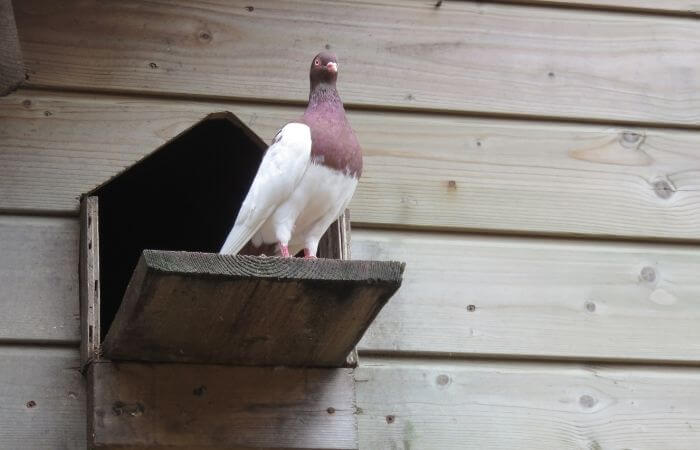
The best thing is to take it step by step and don’t let your enthusiasm run away with you.
Before you rush out and buy your first pigeons you have to think about their accommodation.

New to pigeons? Buy our eBook for a concise guide to everything you need to know, including:
- Suitable breeds
- Raising pigeons from eggs
- Looking after baby pigeons
- Handling
- Cleaning
- Feeding
- Breeding
- Nesting
- and more..
Also Read:
Pigeon Lofts
First, you have to think about where you are going to put your pigeon loft. Most people put them in their gardens, but you can also put them on a roof or even an allotment.
It doesn’t really matter where you put the loft, but you do have to think about adequate space.
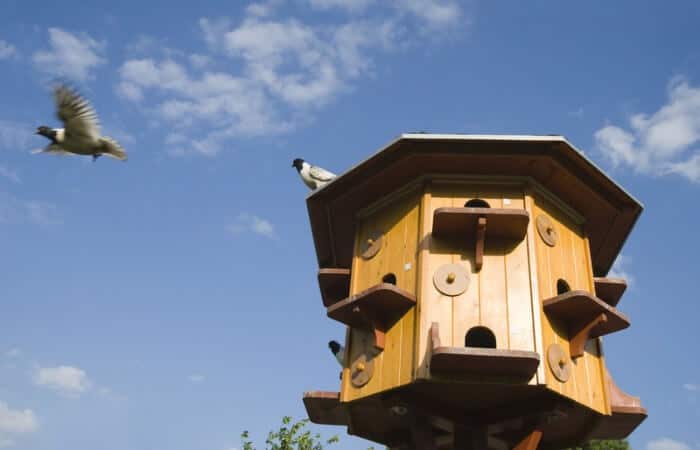
First-time enthusiasts should start out with just a few birds, but you have to think of the future.
As your enthusiasm for these birds grows you will think of getting more.
Also, because of their frequent breeding circle, your pigeon population is going to expand anyway.
Because of that, you will need to situate the loft somewhere it can be expanded as necessary.
Constructing The Loft
You can either buy a pigeon loft or build one yourself.
Building a loft doesn’t have to be complicated, as pigeons don’t require much.
You can start off with an old shed and modify it.
You can even start off with old chicken runs or rabbit hutches, with just a few pigeons.
What you do need inside are shelves or boxes, high off the ground, for them to make their nests and easy entrances so that they can get in and out.
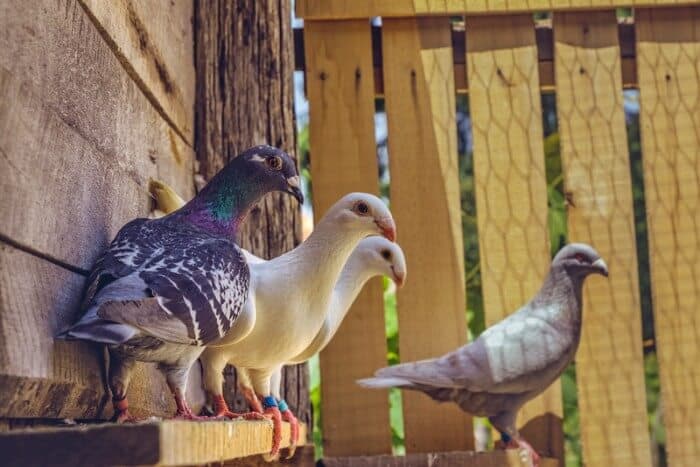
Perches inside the loft are also a good idea as well as areas where you can put their feed and water.
Your pigeon loft doesn’t have to fancy, only functional and secure.
Just take into account that it has to be waterproof, with plenty of airflow and light. Materials such as MDF can be adequately waterproofed with the application of a good sealant.
Attached to it, you need an adequate fenced in area – a cage that surrounds the outside area on all sides, even overhead.
You may let your pigeons out during the day, but mesh or open wire overhead will keep them safe from predators from above or at night.
Birds of prey and cats are a regular menace to pigeons.
It will also be a place of safety during the day, a place to flee to if they feel threatened.
A door with a latch or a spring on it is also a must. One other detail is a small quarantine cage for sick or diseased pigeons.
What to Feed Your Pigeons
The natural food of pigeons is seeds and grains.
They will eat anything that comes under those headings.
There is a wide variety which your pigeons can safely eat.
They will also eat vegetables, berries, or fruits.
Contrary to popular belief, pigeons can and do eat rice safely.
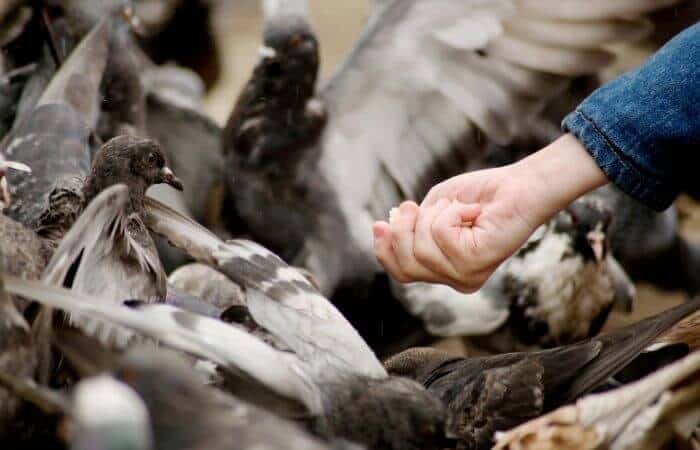
Your aim is to keep and raise healthy pigeons, so you need to give them a balanced diet that includes vitamins, minerals, fat, proteins, and carbohydrates.
Pigeons that are only fed seeds can suffer from calcium deficiency, so make sure that seeds only consist of 50% of your pigeons’ diet.
Proteins should make up another 15%.
You can buy grains and seeds separately and mix them yourself of you can buy pre-mixed pigeon fed from pet shops or pet food outlets.
It is a good idea to vary the feed that you give your pigeons.
The average pigeon will eat between 35-50 grams of food per day, so you can calculate how much feed you need to buy over a certain period.
Remember to add some grit to your mixture too if you are hand mixing the feed.
On the other hand, you can just leave a bowl of grit for the pigeons to use themselves.
The pre-mixed store-bought feed may contain grit already, but it is best to check this out before buying.
This is important because pigeons don’t have teeth and cannot chew.
They swallow their food and it goes straight to their stomachs.
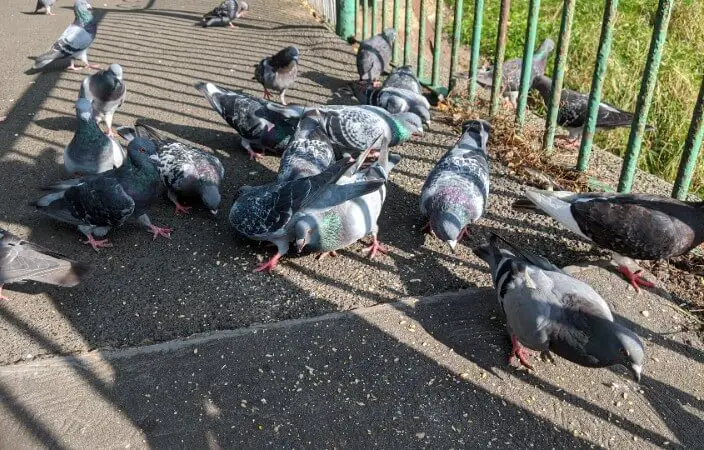
They swallow grit too with their food because it acts like grindstones to break down the feed so the nutrients can be absorbed.
The actual giving of the food can be done by installing bird feeders or simply scattering it on the floor of the loft, it doesn’t matter which.
Pigeons shouldn’t be given anything other than water to drink.
When laying down water for your pigeons make sure that the container is at least one inch deep.
This is because pigeons need to submerge their whole beaks in order to drink.
Pigeons may need different types of nutrition during the different stages of their lives, and also, different breeds may have different feeding needs.
Before you go out and buy anything, it is better to consult a veterinarian.
Baby pigeons or squabs as they are known will take only ‘crop milk’ from their parents for the first few days of their lives, but after will take regular pigeon food.
To ensure that they grow up to be healthy adults it is recommended that they be given a higher protein diet at this stage in their lives.
This can depend on which particular breed of pigeons that you are raising, so seek advice.
Caring for Pigeons
Many people will tell you that pigeons carry diseases that can infect humans.
This is true of pigeons and many other animals, but what they don’t tell you is how.
Many of the diseases that pigeons have are not passed on by physical contact with the birds but through their droppings.
Their droppings fall to the ground where they dry, and this is the problem.

Dried droppings are stepped on and ground into dust.
The dust floats in the air and can be inhaled by humans.
Pigeon fanciers are more prone to infection because of their constant visits to the birds.
The way to combat these airborne pathogens is to keep the loft clean by sweeping up on a regular basis.
Timely cleanliness will protect both you and your birds.
Pigeons groom themselves and bathe too, so sufficient water should be on hand to help them.
A separate cage is recommended to quarantine new birds before introducing them to the loft or isolating sick birds from the rest.

This article was written by our qualified veterinarian Cristina.
This is part of our commitment to providing you with the most trustworthy veterinary advice for your pigeons.
Pigeon Love
Man’s relationship with pigeons stretches far back into ancient history and they are one of the species that has followed man through his evolution.
That relationship has had its ups and downs but has never been severed.
Whether you think pigeons are cute, stately, or a pest, there’s no getting away from them.
It’s no wonder that these birds hold a fascination for many people.
For many, the owning and raising of these lovely birds has given them great pleasure.
